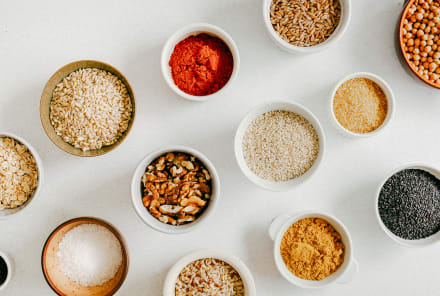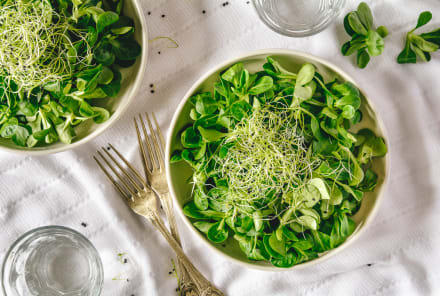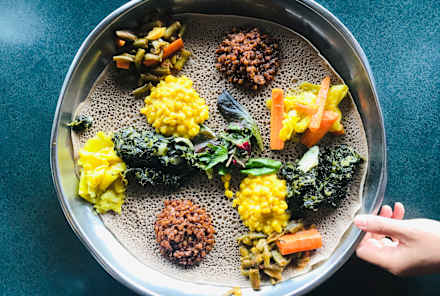Advertisement
Sorghum 101: What It Is, How It Compares To Other Grains & 6 Ways To Cook With It

As grains go, sorghum isn't the most widely known in the U.S. At mealtimes, other choices like wheat, rice, or quinoa are more popular. Yet with so many benefits, this ancient plant could easily be the next big thing in foodie circles. Highly nutritious, sustainably grown, and easy to cook, sorghum checks all the boxes as a smart choice in your diet.
Here's your guide to what sorghum is, how it differs from more popular grains, and how to use it in your cooking for maximum health benefits:
The need-to-knows:
- Sorghum is high in protein & fiber: Compared to grains like rice or quinoa, sorghum is significantly higher in fiber and high-quality protein, making it a filling and gut-friendly option.
- Surghum is a resilient crop: Sorghum requires less water and often fewer pesticides and fertilizers to grow than other grains, making it a sustainable pick.
- You can cook it as you do other grains: Sorghum can be used interchangeably with options like barley, brown rice, millet, or quinoa in recipes.
What is sorghum?
Sorghum is a healthy whole grain packed with fiber, protein, and a variety of micronutrients.
It grows in red, bronze, yellow, tan, white, or black clusters atop stalks throughout the so-called "sorghum belt" of the U.S.—a line of states stretching from South Dakota to Texas. In fact, though it's not always a regular menu item or home-cooked side, more sorghum is grown in the United States than in any other country.
That said, this plant originated in Northern Africa, where its roots stretch back (literally and figuratively) to 8,000 B.C. Along with foods like amaranth, quinoa, and chia, its lengthy history earns sorghum the title of an "ancient" grain.
Never tried sorghum? You're in for a nutty, earthy, chewy treat. The individual grains can be cooked to create a side dish much like quinoa (though they do take longer to soften up). You can drop sorghum into soups and stews, pack it into burger-like patties, or use it as the base of a tasty grain bowl.
Sorghum is naturally gluten-free, so it's a great choice for people with trouble digesting gluten. Besides its versatility as an everyday food, sorghum is also used to make sorghum molasses, some alcohols, and livestock feed.
The other bonus: sorghum's sustainability. It's extremely efficient at using sunlight and water, which makes it tolerant to drought and helps conserve natural resources. The National Sorghum Producers have even trademarked it as The Resource Conserving Crop™.
Summary
Varieties of sorghum
Sorghum not only comes in several varieties in color, but it also has a wide swath of culinary applications. Though you may not find all of the below at your local grocery store, they're used in various stages of food production:
- Whole sorghum grains: These are the kind you'll keep in your pantry for regular use at mealtimes. Boil them for a nutritious side dish or grain bowl.
- Sorghum flour: In either white or whole grain form, sorghum flour can be used in baked goods in both commercial and home baking
- Sorghum syrup: Hey, natural sweetener! Sorghum syrup is created by squeezing the juice from sweet sorghum varieties. Pour it atop pancakes or waffles for a maple syrup alternative.
- Sorghum cereal products: Some breakfast cereals use sorghum in their mix of high-fiber morning grains.
- Popped sorghum: Like popcorn but smaller, popped sorghum is a snack you can eat all by itself or use as a crunchy topping.
- Sorghum bran: Pounded into a powdery meal, sorghum becomes an easy addition to smoothies, shakes, or baked goods.
Sorghum nutrition
In ½ cup of sorghum grains1 you'll find the following nutrition:
- Calories: 321
- Carbs: 69 grams
- Sugar: 2.5 grams
- Fiber: 6.5 grams
- Protein: 10 grams
- Potassium: 350 milligrams
- Phosphorus: 278 milligrams
- Magnesium: 160 milligrams
Wondering how sorghum stacks up to similar grains like brown rice or quinoa? It's higher in calories than these other grain options but also way higher in fiber. A half-cup of sorghum packs 6.5 grams of fiber, compared to about 1.5 grams in the same amount of brown rice and 2.5 grams in quinoa. It also packs twice as much protein as other plant-based sources like quinoa and couscous per serving.
Health benefits of sorghum
Sorghum contains fiber and prebiotics that support gut health
With so much fiber, it's no surprise that sorghum can support a healthy GI tract. Increased daily fiber intake normalizes bowel movements and helps maintain overall bowel health.
According to dietitian Ashley Oswald, RDN, L.D., CNSC, CLT, IFNCP, sorghum contains not just plenty of fiber but prebiotics, too.
"You can think of prebiotics as food for the trillions of microorganisms you have living in your gut (mostly your large intestine)," she says. These good gut bugs feast on fiber, ultimately creating short-chain fatty acids (SCFA). "One SCFA is called butyrate, which is a powerful supporter of your immune system2. Butyrate can also decrease chronic inflammation, improve your gut barrier function (in other words, help with leaky gut), and more," Oswald says.
Sorghum may help with diabetes management
The benefits of sorghum's fiber content extend even further—all that roughage could be helpful for diabetes management.
"Just a half cup of sorghum provides 7 grams of fiber, making it a low-glycemic grain option for [those with diabetes]," says clinical dietitian Huma Chaudhry, R.D., LDN. "It is high in insoluble fiber, which absorbs water during digestion and turns into a gel-like substance which can help slow down digestion and prevent blood sugar spikes."
A 2023 study found that eating sorghum-based food products might help control the body's glycemic response, lowering one's risk of developing metabolic diseases like diabetes3 in the first place.
Sorghum could help reduce blood pressure
According to the FDA, 90% of American adults4 eat more than the recommended amount of sodium—which can lead to high blood pressure levels.
One way to combat excess dietary sodium is to balance it with potassium. Since sorghum provides an impressive 350 milligrams of potassium (and negligible amounts of sodium), it's an excellent choice for your BP.
The antioxidants in these chewy grains have their own positive effect on blood pressure. "Sorghum contains beneficial plant compounds like polyphenols and flavonoids, which can help reduce inflammation and relax blood vessels5," Chaudhry says.
Sorghum is pretty high in protein
Vegetarians and vegans often have trouble filling their daily protein needs (100+ grams a day for most active people) with plants alone. Sorghum contains more than twice the protein of other grains, an impressive 20.4 grams per cup1. A cup of sorghum also contains over 2.5 grams of the amino acid leucine, enough to activate muscle protein synthesis and support muscle growth and maintenance.
If you're looking to eat more high-quality protein daily, sorghum is a great grain to have in your rotation.
Summary
How to cook with it
For those unfamiliar with sorghum, adding it to a mealtime routine might seem like a daunting prospect. Try these simple ways to ease into cooking with sorghum:
- Make it in place of rice or quinoa as a dinnertime side dish
- Add it to soups and stews
- Make it the base of a veggie-rich grain bowl
- Use it as a substitute for barley in tabbouleh
- Try sorghum flour instead of half the wheat flour in muffins or tortillas
- Toss popped sorghum onto salads for extra crunch
Buying tips
If you can't find sorghum at your local grocery store, look online. Plenty of retailers supply a variety of sorghum products by mail. Whenever possible, choose an organic variety for reduced environmental footprint. Since the majority of sorghum is grown in the U.S., it's likely that any you purchase will be American-grown, but check sourcing info online to be sure if buying local is something that's important to you.
Sorghum vs. other grains
- Millet: Like sorghum, millet is a gluten-free cereal grain. It's slightly higher in protein than sorghum6 but lower in fiber.
- Wheat: Wheat flour and sorghum flour can both be used in baking, but their flavors will differ. Whereas wheat has a milder taste, you may notice a stronger, nuttier flavor in foods made with sorghum flour.
- Molasses: Sorghum's naturally sweet syrup is often used as a topping (try it on pancakes!), whereas molasses is thicker and works better as an ingredient in baked goods and sauces.
If a recipe calls for sorghum and you don't have any on hand, various substitutes will suffice. In a simple side dish or as an addition to soups, consider barley, brown rice, millet, or quinoa.
In place of sorghum flour, gluten-free grains like buckwheat flour or chickpea flour should do the trick.
Other perspectives on sorghum
Though sorghum is a healthy food, it might not be for everyone. Those who follow a grain-free diet, such as people on a Whole30 diet, will likely pass on sorghum. (The theory behind Whole30 goes that proteins in grains increase gut permeability, leading to inflammation.) Still, for most people, the benefits of sorghum probably outweigh any drawbacks.
The mindbodygreen POV
Sorghum is a versatile ingredient that contains a good amount of plant-based protein and fiber. Protein is essential for muscle growth and body composition, while fiber is needed for a healthy gut microbiome. Sorghum also requires less water to grow and is more resistant to pests and diseases7 than other cereal grains, making it a sustainable option. We'd recommend using sorghum in place of less nutrient-dense refined grains like white rice when possible.
Reasons to avoid sorghum:
Sorghum isn't among the top food allergens, so you're unlikely to have an adverse reaction to it. But there may be other cases where you'll want to skip sorghum.
"If someone is having gut issues and doesn't tolerate fiber well, then they will want to try a small amount of sorghum for their first time and ramp up from there, given its high fiber content," says Oswald.
Also, if you have celiac disease, look for a certified gluten-free sorghum. Sorghum itself is gluten-free, but, depending on where it's processed, it could come into contact with other grains that contain gluten. A certified GF product will ensure you don't get any cross-contamination.
FAQ
What does sorghum taste like?
Mild, earthy, and nutty are words most people use to describe sorghum's flavor. When cooked, it has a pleasantly chewy texture that might remind you of rice or quinoa.
What grain is sorghum similar to?
Sorghum is actually a relative of corn—but the two don't bear much similarity in cooked, ready-to-eat form. Instead, sorghum tastes and cooks much more like grains such as quinoa, barley, rice, or couscous. Or, if you make it as a porridge, it can resemble oatmeal.
What is sorghum used for?
What is sorghum not used for? Cereals, syrups, baked goods, porridges, salads, and even plant-based burgers can all incorporate different forms of this grain.
The takeaway
There's a lot to like about sorghum, from its solid sustainability to its fiber rock star status. The only downside might be that it's a bit harder to come by than some other common grains. If you've never tried this healthy ancient grain, get your sorghum on by whipping up a grain salad, an herby pilaf, or a grain-rich stew. While you're at it, here are some more ancient grains to add to your plate.
7 Sources
- https://fdc.nal.usda.gov/fdc-app.html#/food-details/169716/nutrients
- https://pubmed.ncbi.nlm.nih.gov/34819742/
- https://pubmed.ncbi.nlm.nih.gov/34357823/
- https://www.fda.gov/consumers/consumer-updates/eating-too-much-salt-ways-cut-backgradually
- https://www.ncbi.nlm.nih.gov/pmc/articles/PMC8840535/
- https://fdc.nal.usda.gov/fdc-app.html#/food-details/2512379/nutrients
- https://www.frontiersin.org/articles/10.3389/fsufs.2022.742909/full

Why Nutrition Is Key To Changing Your Relationship With Alcohol
Brooke Scheller, DCN, CNS

Why Alcohol Sabotages Your Gut Health & How To Get Back On Track
Brooke Scheller, DCN, CNS

Why Nutrition Is Key To Changing Your Relationship With Alcohol
Brooke Scheller, DCN, CNS

Why Alcohol Sabotages Your Gut Health & How To Get Back On Track
Brooke Scheller, DCN, CNS

Why Nutrition Is Key To Changing Your Relationship With Alcohol
Brooke Scheller, DCN, CNS

Why Alcohol Sabotages Your Gut Health & How To Get Back On Track
Brooke Scheller, DCN, CNS

Why Nutrition Is Key To Changing Your Relationship With Alcohol
Brooke Scheller, DCN, CNS

Why Alcohol Sabotages Your Gut Health & How To Get Back On Track
Brooke Scheller, DCN, CNS














